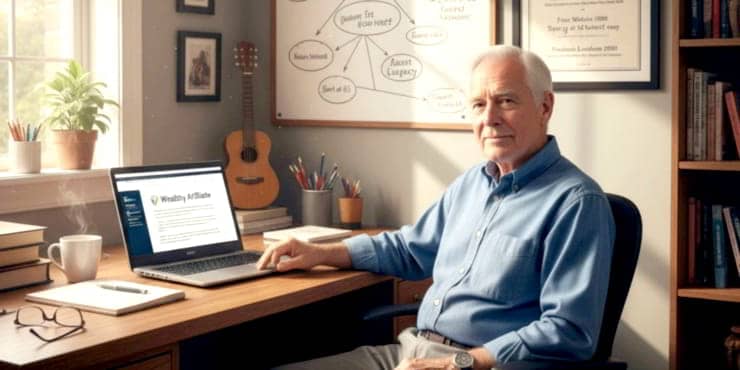Easy WordPress SEO: Tips and Tricks for Ranking Higher

Estimated reading time: 9 Min
Easy WordPress SEO. How to tune your WordPress site for search engines and humans at the same time. Tips and tricks.
Think of your WordPress site as your favourite string instrument. Mine’s a violin.
Just as a violin must be finely tuned to produce the most beautiful music, your website must be finely tuned to reach the top of the search engine results pages.
SEO, or Search Engine Optimisation, is the art of tuning your website so that search engines like Google sit up and take notice.
But don’t worry, you don’t need to be a maestro to master SEO.
With a few simple adjustments and regular upkeep, your WordPress site can perform like a concert violinist at the Royal Albert Hall.
Setting the Stage: Easy WordPress SEO Settings
Before a musician performs, they set the stage, ensuring everything is in place for a flawless concert.
Similarly, certain settings on your WordPress site must be adjusted for optimal SEO performance.
Permalinks
Navigate to Settings > Permalinks.
Here, choose a structure that includes the post title.
This isn’t just for looks; it helps search engines understand what your page is about, much like how the name of a piece of music sets expectations.
Keep the structure as simple as possible; just the domain name and post title is enough.
Visibility Settings
In the Reading settings, ensure that the box next to “Discourage search engines from indexing this site” is unchecked.
This makes sure that search engines at least crawl your site for the purposes of indexing.
Content Composition: Crafting Posts and Pages that Sing
Content is the heart of your website.
For SEO, not just any content will do; it needs to be high-quality, relevant to searchers and to the title used, and, above all, engaging.
Engaging Content
Just as a captivating melody keeps the audience’s attention, captivating content keeps your readers engaged.
Use headings and subheadings to structure your posts, making them easier to read (and easier for search engines to understand).
In addition, adding appropriately themed images, infographics, and videos can help.
Keyword Placement:
Incorporate relevant keywords naturally, as if weaving a theme through a musical composition.
But beware; just like a repeated note can become tiresome, overuse of keywords can annoy your readers, be noticed by search engines, and penalise your SEO.
Internal and External links

Once you’ve composed various parts of a longer piece of music, it’s important to make sure they link to each other in a relevant way, thereby leading the listener seamlessly from section to section.
Similarly, your posts and pages can and should be linked together, both for the convenience of readers and search engines.
Internal links can take the reader from selected words to other relevant positions, posts, or pages.
You can also add outgoing, external links to third party sites either for further relevant, related information or to take readers to relevant sales or affiliate pages.
The Technical Tune-up: Under the Hood of WordPress SEO
Every musician knows the importance of a well-maintained instrument.
Similarly, the technical aspects of your site need regular tune-ups to perform well in search engine rankings.
Speeding Up Your Site
A slow-loading site is like a slow-starting symphony; it can lose the audience before the performance even begins.
Optimise images, use caching, and consider a content delivery network to keep your site quick on its feet.
Mobile Optimisation
More people than ever are using mobile devices to browse the internet.
Ensure your site is responsive and looks great on all devices. Most WordPress themes are responsive nowadays.
Keywords: The Notes of SEO Music
In the realm of SEO, keywords are like the notes that make up your website’s melody.
They are the terms and phrases that your audience types into search engines to find content like yours.
But how do you choose the right keywords, and how do you use them effectively?
Understanding Keyword Research

Think of keyword research like choosing the right notes for a song.
You want to select keywords that are popular enough to be searched for but not so popular that there’s too much competition.
Use tools like Google Keyword Planner, SEMrush, or, as I do, Jaaxy (available to Wealthy Affiliate members) or Keywords Everywhere to find the sweet spot.
Balancing Keyword Density
Just as a beautiful piece of music balances different notes and rhythms, your content should balance keywords.
They should appear naturally within the text without overpowering the message.
Aim for a keyword density that keeps the content readable and enjoyable, similar to how a well-composed piece of music flows naturally.
Backlinks: Building the Chords of Website Authority
If keywords are the notes of SEO, then backlinks are the chords that give those notes depth and harmony.
Backlinks are links from other websites to your site, and they are a critical factor in how search engines rank your site.
Strategies for Building Backlinks
Think of building backlinks as networking with other musicians.
Guest blogging, participating in online communities, and creating high-quality, shareable content can encourage others to link to your site.
But remember, the quality of the backlink is far more important than the quantity, much like how a few well-played chords can be more impactful than a flurry of disjointed notes.
Avoiding Black-Hat Techniques:
Just as in music, integrity matters in SEO.
Avoid black-hat techniques such as buying backlinks or participating in link schemes.
These are the equivalent of lip-syncing in a live concert; they can damage your reputation and your rankings.
Social Signals and Engagement: The Audience’s Applause
In the world of SEO, your audience’s reaction can be just as important as the content itself.
Social signals, like shares, likes, and comments, can indicate to search engines that people find your content valuable.
Boosting Social Signals
Encourage readers to share your content by adding social sharing buttons to your WordPress site and engaging with your audience on social media platforms.

It’s like encouraging applause at the end of a performance; it not only feels great, but it also signals to others that your content is worth paying attention to.
Integrating Social Media
Make sure your WordPress site is connected to your social media profiles.
This not only helps with social signals but also allows your audience to engage with you more easily, creating a community around your content, much like fans following their favourite musician on tour.
Continuous Performance: The Art of SEO Maintenance
SEO isn’t a one-time performance; it’s an ongoing concert that requires constant attention and improvement.
Just as a musician must continue to practice and perform, you must continue to monitor and update your SEO strategies.
Regular SEO Audits
Conduct regular SEO audits to identify areas of improvement.
This is like a musician listening to recordings of their performances to find areas where they can improve.
Keeping Content Fresh
Update old posts with new information, links, and keywords.
This keeps your site relevant and engaging, much like how a musician might update their repertoire with new songs.
Staying Informed
SEO is an ever-changing field, with search engines constantly updating their algorithms.
Stay informed about the latest trends and changes in SEO, much like a musician stays on top of the latest music trends.
Plugins and Tools: The Instruments of SEO
Just as a musician relies on their instruments, you can rely on various plugins and tools to help with your WordPress SEO efforts.
Essential WordPress SEO Plugins
Plugins like Rank Math, SEO Framework, Yoast SEO, or All in One SEO Pack can provide a solid foundation for your SEO efforts, offering features like sitemap generation, meta tag optimisation, and more.
However, realise that the SEO scoring that such systems provide is more of an education tool for the user than anything else and does not actually make a difference to the quality of your SEO unless you follow the advice given.
Choosing the Right Tools
Evaluate which tools and plugins best fit your needs.
Consider factors like your site’s size, your SEO goals, and your budget, much like a musician chooses their instruments based on their musical style and needs.
FAQs
1. How often should I update my WordPress site for SEO?
Think of your website as a living, breathing entity. Just like a musician practices regularly, your website needs regular updates to stay relevant. Aim to review your SEO settings and update your content at least once a quarter. For best results, monitor your site’s performance monthly and adjust as needed.
2. Can I improve my WordPress SEO without plugins?
Absolutely, just as you can make music without the most expensive instrument. However, plugins like Yoast SEO and All in One SEO make it easier to manage your SEO efforts, similar to how a good instrument can make music creation easier. Without plugins, you’ll need to manually manage aspects like sitemaps, meta tags, and social media integration.
3. How important are keywords in WordPress SEO?
Keywords are like the lyrics to your website’s song. They’re crucial for letting search engines and users know what your site is about. However, it’s important to use them naturally and in context. Overusing keywords can backfire, similar to a song with repetitive, uninspiring lyrics.
4. How can I make my WordPress site faster?
Website speed is crucial for SEO and the user experience. You can improve your site’s speed by optimising images, using a caching plugin, and choosing a reliable hosting service. Think of it as tuning your instrument for better sound quality—the better it performs, the better the audience’s experience.
5. What should I do if my WordPress site isn’t showing up in search engine results?
First, check your site’s visibility settings to ensure search engines can index your site. Then, review your SEO basics: Are your permalinks structured correctly? Are you using keywords effectively? Is your site mobile-friendly? It’s like checking your instrument’s tuning, strings, and sound before a performance. If you’re still facing issues, consider seeking help from an SEO professional.
Summary: Your WordPress Site, Optimised
Congratulations!
You’ve made it through the performance, and now it’s time to take a bow.
Your WordPress site is now better tuned for the search engines, ready to face the music of the online world.
But remember, SEO is a continuous journey. Just like a musician who never stops learning, your SEO efforts should evolve and grow over time.
Ready to Conduct Your SEO Symphony?
Now that you’ve tuned your WordPress site with the finest SEO practices, it’s time to show to the world.
But remember, the concert never truly ends. There’s always the next performance.
SEO is an ongoing performance, a discipline that evolves with every algorithm update and every new piece of content you create.
Need a helping hand to fine-tune your website’s SEO performance?
Reach out via the contact form, and let’s make your site perform well with the search engines!
Remember, each small step in SEO is like learning a new note or chord; it builds up to a grand performance. So, why wait? Start fine-tuning your WordPress site today and watch it climb the search engine charts!
If you have anything to add, or questions, feel free to add a comment.
🙂
Richard


![Are Wealthy Affiliate Hubs Revolutionising Website & Content Development In [year]? A futuristic and sleek digital workspace designed for website management and content creation - Wealthy Affiliate Hubs](https://ml0yvzumdtic.i.optimole.com/cb:k6B_.1fa14/w:740/h:370/q:mauto/https://solobusinessmind.com/wp-content/uploads/2024/12/A-futuristic-and-sleek-digital-workspace-designed-for-website-management-and-content-creation-Wealthy-Affiliate-Hubs740x370-O.jpg)



